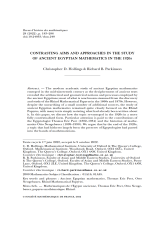L’étude des mathématiques de l’Égypte ancienne dans les années 1920 : des objectifs et des approches contrastés
Contrasting aims and approaches in the study of ancient Egyptian mathematics in the 1920$ \text{s}$

- Consulter un extrait
- Année : 2022
- Fascicule : 2
- Tome : 28
- Format : Électronique
- Langue de l'ouvrage :
Anglais - Class. Math. : 01A16, 01A85
- Pages : 183-286
- DOI : 10.24033/rhm.240
L’étude des mathématiques de l’Égypte ancienne s’est constituée en champ académique au milieu du xixe siècle lorsque le déchiffrement des textes anciens a révélé les notions et les processus arithmétiques et géométriques employés par les anciens Égyptiens; la majorité de nos connaissances actuelles découle de la découverte et de l’étude du papyrus mathématique Rhind dans les années 1860 et 1870. Cependant, malgré la découverte d’un petit nombre de sources supplémentaires, l’étude des mathématiques de l’Égypte ancienne est restée assez étroitement centrée sur le papyrus Rhind, de nombreux textes ne faisant que reprendre ce qui avait déjà été écrit à son sujet. Dans cet article, nous discutons de la façon dont le sujet a réémergé dans les années 1920 sous une forme davantage contextualisée. Une attention particulière est accordée aux contributions de l’égyptologue Thomas Eric Peet (1882-1934) et de l’historien des mathématiques Otto Neugebauer (1899-1990). Nous soutenons qu’à la fin des années 1920, ce sont les mathématiciens qui se sont saisis de ce sujet, qui avait jusque-là été largement l’apanage des égyptologues.

